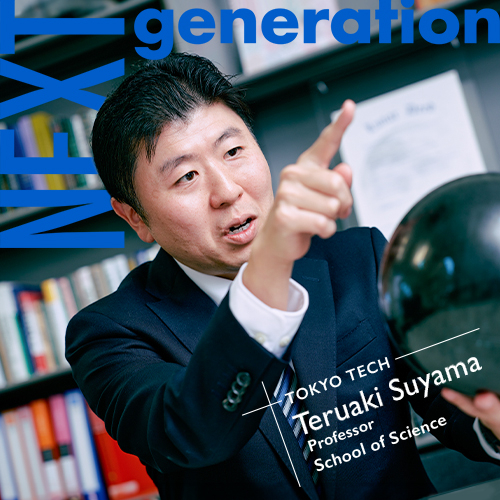On September 14, 2015, the American gravitational-wave observatory LIGO observed gravitational waves for the first time in history. The penetrability of gravitational waves should make it possible to observe the universe immediately after its birth. Professor Teruaki Suyama of the Department of Physics, School of Science, specializes in "modern cosmology," and is conducting theoretical research based on gravitational waves to unravel the fundamental mysteries of the universe, such as the nature of black holes that formed in the early universe and of dark matter, which is believed to make up the majority of the universe.
Gravitational waves — a shocking discovery
- What did you think when LIGO succeeded in directly observing gravitational waves? And what impact does this have on space research?
I had heard about the first observation and was looking forward to the press conference in Washington, D.C. The first thing Dr. David Reitze (executive director of LIGO) said at the press conference was, "We have detected gravitational waves!" I was very excited.
Gravitational waves are phenomena in which time and space distortions (i.e., space-time distortions) caused by the motion of massive celestial objects propagate like waves at the speed of light. It was predicted by Einstein's general theory of relativity and had been indirectly confirmed, but had not been directly observed.
I have been doing theoretical research on gravitational waves since my graduate school days. Gravitational waves are so weak that if two objects were 1 meter apart, they would only vibrate about 10-20 meters, or about 1/100,000th of the size of a proton, so I thought there was no way to capture such waves and that it would be almost impossible to observe them in my lifetime. Therefore, I was shocked when I learned that they had actually been found.

Cosmologists have tried to see the early universe by observing light coming from its oldest days. Until now, "cosmic microwave background radiation," which is observed nearly isotropically from all directions in the universe, has been the light best suited for seeing the early universe. However, because the temperature was too high immediately after the birth of the universe for light to travel straight ahead, that light cannot reach us today and cannot be observed.
But since gravitational waves have high penetrability, they can be a powerful cosmic observation tool and reach us even if they were emitted just after the birth of the universe. Although we have not yet found gravitational waves emitted immediately after the birth of the universe, more than 100 gravitational waves have already been observed since LIGO's observations. We believe that further development of gravitational wave observation technology will enable us to observe gravitational waves from the early universe and further unravel its mysteries.
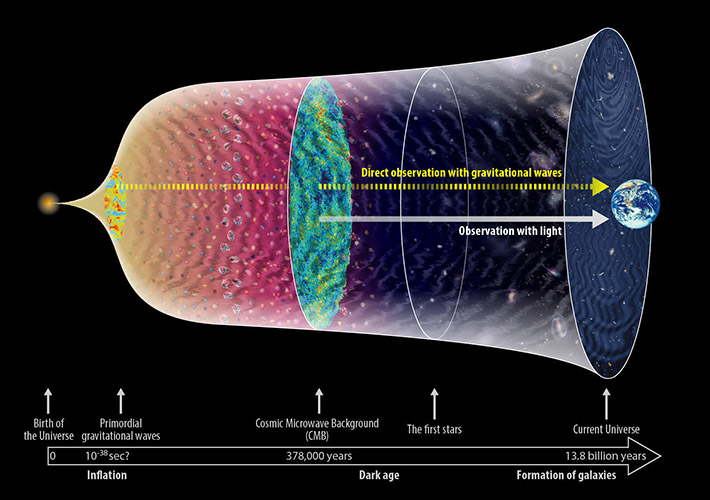
Density fluctuation in the early universe
Courtesy of NAOJ
Physics-based modern cosmology
- How was the universe born, how did it grow, and what will happen to it in the future? Tell us about recent "modern cosmology".
Modern cosmology is a physics-based field that studies the history and formation of the universe. The origin and formation of the universe have been of great interest to people since ancient times. Observing the movement of the stars and galaxies was the main means of observation, but there were also myths such as the earth being supported by four elephants, who were standing on the shell of a turtle.
The idea that the universe is eternal has been dominant since ancient times, but in the 1920s, a theory was proposed that the universe began with a Big Bang that occurred long ago. The idea is that more distant galaxies are observed to be moving away faster, and the universe is continuing to expand. Theoretically, the "general theory of relativity" proved that the entire universe is expanding, and the validity of the Big Bang theory was accepted. Subsequent studies have estimated that the Big Bang occurred 13.8 billion years ago.
So how did the stars and galaxies in the nascent universe form? This is explained by the "inflation theory" proposed by Professor Emeritus Katsuhiko Sato at the University of Tokyo and other researchers in 1981. The idea is that the universe expanded rapidly from a high-temperature, high-density energy state in the short period of 10-35 seconds immediately after its birth. As scientists observed various places in the universe, they found that, strangely enough, the structure is all the same. The reason for this can be traced to the theory that the universe originated from a single place of the same origin and expanded rapidly.
In this case, if we apply quantum mechanics, even in the immediate post-birth state, space is always fluctuating, creating an uneven energy density. It is thought that in areas of high density, gravity attracts more and more material from the surrounding area, and in areas of low density, the density becomes increasingly lower, thus increasing the density gradient. This is how stars and galaxies were formed.
Modern cosmology has progressed rapidly in recent decades. With more and more revelations from observations of gravitational waves along with theoretical developments, new questions are being raised in rapid succession. There is also much about inflation theory that has yet to be clarified.
In addition, matter such as stars and galaxies comprise only 4.9% of the total universe, and the rest is referred to as dark matter and dark energy, the true nature of which has yet to be revealed. I believe that the search for their true nature is an extremely important challenge that is not limited to the quest to understand the universe, but involves a wide range of fields.
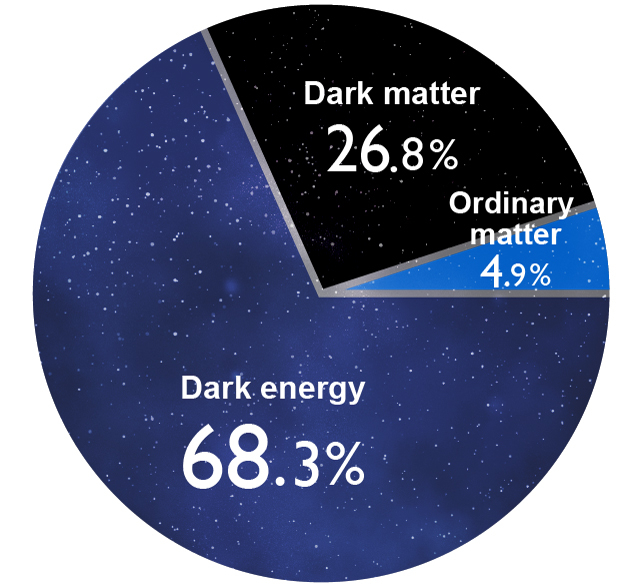
Breakdown of matter in the universe
Was it primordial black holes that emitted gravitational waves?
- Please tell us about the research that you are working on.
I am researching primordial black holes and dark matter.
We found that the gravitational waves observed by "LIGO" were those emitted when two black holes formed a binary star and merged. However, the origin of these black holes is not known. Both have masses 36 and 29 times greater than the Sun, and I am investigating the possibility that they are primordial black holes, since black holes with masses dozens of times greater than the Sun were thought to be few and far between in the universe.
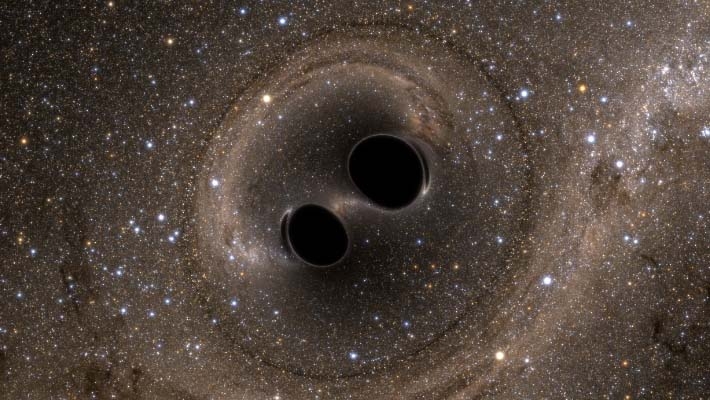
Image of black hole merger that gave rise to gravitational waves
Courtesy Caltech/MIT/LIGO Laboratory
Unlike black holes formed by the collapse of stars, primordial black holes are thought to have formed shortly after the birth of the universe. In other words, they are thought to have been created by gravitational contraction in a region of particularly high energy density. Theoretically, we know that such a black hole could exist, but no conclusive evidence of its existence has been found so far, despite various methods of exploration. If its existence is confirmed, it should further our understanding of inflation theory.
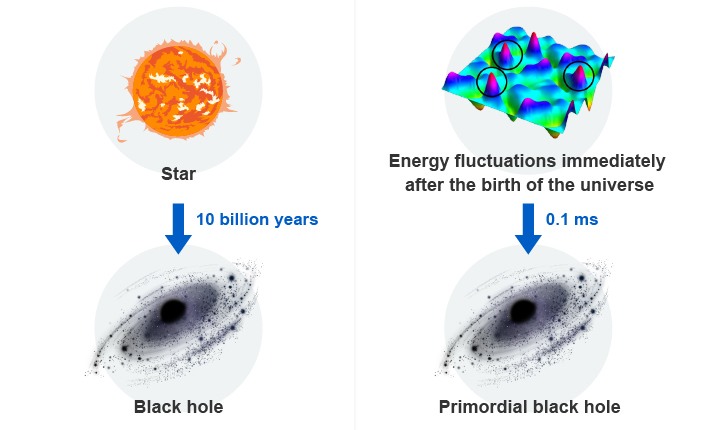
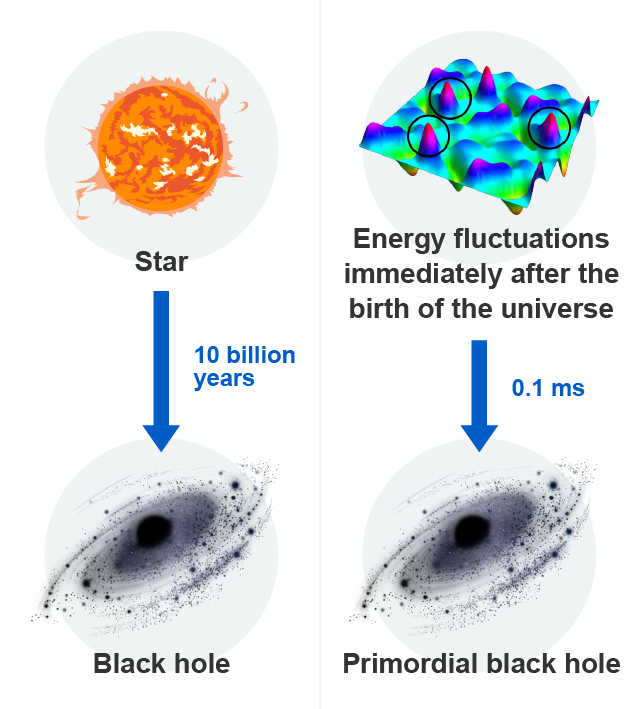
Differences in the formation of black holes and primordial black holes
Before the first observation of gravitational waves, scientists said that even if a star were to become a black hole at the end of its lifetime, it would not become a heavy black hole with a mass about 30 times that of the sun. However, after receiving the observation results and recalculating, it was found that it is in fact possible. Therefore, it has not been settled whether the black hole observed by LIGO is a primordial black hole or a black hole of a star at the end of its life.
Gravitational waves bring us closer to the true nature of dark matter
- I have heard that primordial black holes are one of the candidates for dark matter.
That is correct. Dark matter is a substance in the universe that exists in large quantities but cannot be seen, so its true nature is unknown. Scientists consider unknown elementary particles and primordial black holes a possibility.
If the black hole found in the 2015 gravitational wave observations was a primordial black hole, the issue would be whether it could explain dark matter. Since the total mass of dark matter in the universe is known from measurements of the strength of gravity exerted by dark matter, we compared it to black holes found in gravitational wave observations to verify the possibility that massive primordial black holes are dark matter.

What we found was that such massive primordial black holes account for only 0.1% of dark matter and are not a major component of dark matter. This is because if there were many more primordial black holes than this, mergers would occur more frequently than seen in gravitational wave observations.
On the other hand, the possibility remains that light primordial black holes of 1020 to 1022 grams are dark matter. For this reason, there is currently a great deal of research being conducted to determine whether light primordial black holes are a major component of dark matter.
- Can we learn what dark matter is from gravitational wave observations?
The fact that the observation of gravitational waves revealed for the first time that dark matter is not a black hole of a stellar mass such as the sun, reaffirmed for me the power and potential of gravitational wave observations. Therefore, we are currently working to reveal the true nature of dark matter using gravitational waves.
Dark matter is also present in large quantities in the Milky Way galaxy, but it is not known how dark matter is distributed within it. If dark matter is not a primordial black hole, then it is an unknown elementary particle. In this case, the mass of the elementary particle is the crucial point. To a certain extent, dark matter can fly if it is light, so it should be distributed evenly throughout space. Conversely, if it is heavy, it should be distributed as several clumps.
Therefore, we believe that if we can determine the distribution of dark matter in the Milky Way galaxy, we will be able to understand the properties of the matter that makes up the dark matter. And I believe that gravitational waves can be used to determine how dark matter is distributed.
Specifically, when a gravitational wave arrives from far away, if the distribution of dark matter is uneven, the gravity created by the dark matter will cause the wavefront of the gravitational wave to fluctuate slightly. This phenomenon is called the "gravitational lensing effect". By observing the fluctuating gravitational waves, we can learn the distribution of dark matter.
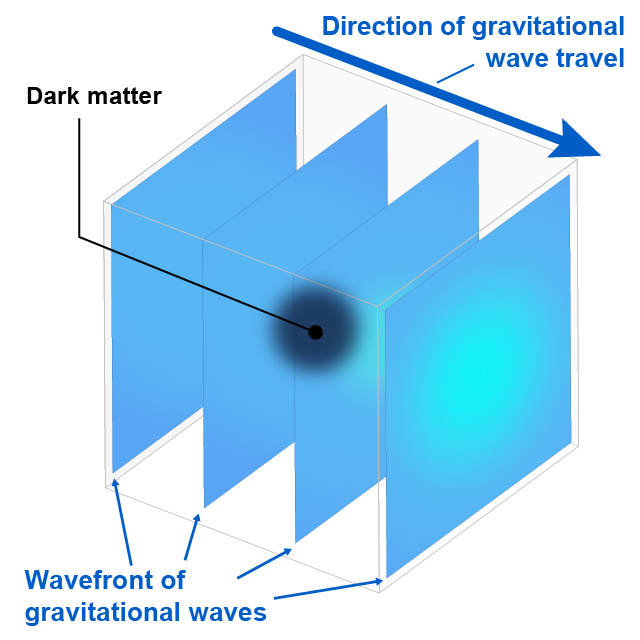
Gravitational lensing effect
Unfortunately, at the current level of observation, it is not possible to observe the gravitational lensing effect of dark matter. We need a more sensitive next generation gravitational wave detector. The gravitational wave detectors in operation are second generation, and the United States and Europe are developing third generation gravitational wave detectors. The project is expected to be completed in 10 to 20 years. This will also allow us to observe the gravitational lensing effects of dark matter.
Europe and China also plan to launch gravitational wave detectors into space. The reason is that ground-based gravitational wave detectors target gravitational waves between 10 Hz and 1,000 Hz, and observing gravitational waves at frequencies lower than 10 Hz is difficult due to ground vibrations. Therefore, we are trying to observe gravitational waves at frequencies as low as mHz in space, where there are no ground vibrations. Low-frequency gravitational waves are extremely important in astrophysics because when massive black holes merge into binary stars, they emit low-frequency gravitational waves.
- Please tell us about your future goals.
Currently, my research focuses on theoretical studies of the gravitational lensing effect of gravitational waves. In fact, I have recently begun working with LIGO researchers to study waveforms associated with the gravitational lensing effect of gravitational waves, using actual observational data. My goal for the next 10 years is to detect the gravitational lensing effect of gravitational waves, while also collaborating with researchers in data analysis. By doing so, I hope to unravel the true nature of dark matter.
Inspired by the theory of relativity, which enables us to approach the truth of all natural phenomena, he entered the field of physics
- How did you become a researcher in modern cosmology?
I chose physics at university because of a book I read on the theory of relativity when I was in high school. Both special and general relativity belong to simple theories, but the fact that we can approach the truth of all natural phenomena from these simple theories is what makes physics so amazing. Then I began researching modern cosmology in graduate school.

I think that the appeal of basic cosmology research lies in its ability to arouse people's intellectual curiosity and inspire them to explore the mysteries of the universe.
- What do you value as a researcher?
I am mindful of what my advisor told me when I was in graduate school. That was, “find a research topic for which there is no prior research”. If there is prior research, simply improving some of it will be an achievement. But that does not make you a pioneer in that field of research. Therefore, although it carries risks, I value finding and investigating research topics on my own that have little prior research. Research on the gravitational lensing of gravitational waves is an example of just that.
- In closing, do you have a message for students who want to become researchers?
To do research, you have to think for yourself and pave your own way. Conversely however, the greatest attraction and real pleasure is the freedom to do what you want to do. I hope that many young people will get to experience that real pleasure.

Teruaki Suyama
Professor, Department of Physics, School of Science
- October 2023 - present: Professor, Department of Physics, School of Science, Tokyo Institute of Technology
- April 2018 - September 2023: Associate Professor, Department of Physics, School of Science, Tokyo Institute of Technology
- August 2012 - March 2018: Assistant Professor, Research Center for the Early Universe, The University of Tokyo
- April 2010 - July 2012: JSPS Postdoctoral Researcher (PD), Research Center for the Early Universe, The University of Tokyo
- October 2008 - March 2010: Postdoctoral Researcher, Catholic University of Louvain
- April 2007 - September 2008: JSPS Research Fellowship for Young Scientists (SPD)
(Swiss Federal Institute of Technology Lausanne)
- March 2007: Ph.D., Graduate School of Science, Kyoto University
- March 2004: M.S., Graduate School of Science, Kyoto University
- March 2002: B.S., School of Science, Osaka University

NEXT generation is a new series about emerging researchers, working at the forefront of science and technology as they envision the impact their discoveries will have on society's future.
The Special Topics component of the Tokyo Tech Website shines a spotlight on recent developments in research and education, achievements of its community members, and special events and news from the Institute.
Past features can be viewed in the Special Topics Gallery.
. Any information published on this site will be valid in relation to Science Tokyo.



